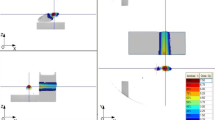Colony-stimulating factor 1 receptor (CSF1R) possesses tyrosine kinase activity. Activation of CSF1R expressed on the surface of brain microglia allows repopulation of microglial cells. Administration of pexidartinib (PD, 40 mg/kg, gavage, 7 d), a CSF1R inhibitor, to mice decreased the number of microglial cells by 90%. Head irradiation at a dose of 8 Gy caused the development of neuroinflammation, as evidenced by the increased fraction of activated microglia in brain-cell preparations, and cognitive impairments two months after the exposure. Administration of PD prior to head irradiation prevented microglia activation. An analysis of episodic memory in the novel-object recognition test and of hippocampus-dependent spatial memory in the Morris water maze test showed that decreasing the number of microglial cells by PD administration prior to irradiation preserved episodic and spatial memory in irradiated mice.



Similar content being viewed by others
References
S. Balentova and M. Adamkov, Int. J. Mol. Sci., 16(11), 27796 – 27815 (2015).
S. Y. Hwang, J. S. Jung, T. H. Kim, et al., Neurobiol. Dis., 21(3), 457 – 467 (2006).
V. H. Perry and C. Holmes, Nat. Rev. Neurol., 10(4), 217 – 224 (2014).
V. Chitu and E. R. Stanley, Curr. Opin. Immunol., 18(1), 39 – 48 (2006).
M. R. Elmore, A. R. Najafi, M. A. Koike, et al., Neuron, 82(2), 380 – 397 (2014).
J. Han, K. Zhu, X. M. Zhang, et al., Glia, 67(2), 217 – 231 (2019).
R. J. Henry, R. M. Ritzel, J. P. Barrett, et al., J. Neurosci., 40(14), 2960 – 2974 (2020).
R. A. Rice, J. Pham, R. J. Lee, et al., Glia, 65(6), 931 – 944 (2017).
E. Burton, B. Wong, J. Zhang, et al., Blood, 118(21), 3632 (2011).
A. S. Zhirnik, O. D. Smirnova, Yu. P. Semochkina, et al., Radiats. Biol. Radioekol., 61(1), 32 – 43 (2021).
A. S. Zhirnik, A. V. Rodina, Yu. P. Semochkina, et al., Med. Radiol. Radiats. Bezop., 67(5), 10 – 17 (2022).
M. Li, Z. Li, H. Ren, et al., J. Cereb. Blood Flow Metab., 37(7) 2383 – 2395 (2017).
E. Shi, K. Shi, S. Qiu, et al., FASEB J., 33(8), 9616 – 9626 (2019).
M. R. Elmore, R. J. Lee, B. L. West, et al., PLoS One, 10(4), e0122912 (2015).
M. M. Acharya, K. N. Green, B. D. Allen, et al., Sci. Rep., 6, 31545 (2016).
R. Roskoski, Jr., Pharmacol. Res., 152, 104609 (2020).
Y. N. Lamb, Drugs, 79(16), 1805 – 1812 (2019).
Author information
Authors and Affiliations
Corresponding author
Additional information
Translated from Khimiko-Farmatsevticheskii Zhurnal, Vol. 57, No. 4, pp. 12 – 16, April, 2023.
Rights and permissions
Springer Nature or its licensor (e.g. a society or other partner) holds exclusive rights to this article under a publishing agreement with the author(s) or other rightsholder(s); author self-archiving of the accepted manuscript version of this article is solely governed by the terms of such publishing agreement and applicable law.
About this article
Cite this article
Rodina, A.V., Zhirnik, A.S., Semochkina, Y.P. et al. Efficiency of Pexidartinib, an Inhibitor of Receptor Tyrosine Kinases, in Reducing Radiation-Induced Neuroinflammation and Improving Cognitive Functions. Pharm Chem J 57, 476–480 (2023). https://doi.org/10.1007/s11094-023-02908-y
Received:
Published:
Issue Date:
DOI: https://doi.org/10.1007/s11094-023-02908-y




